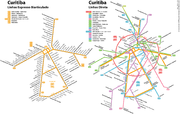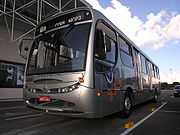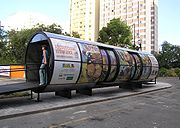
Rede Integrada de Transporte
Encyclopedia


Bus rapid transit
Bus rapid transit is a term applied to a variety of public transportation systems using buses to provide faster, more efficient service than an ordinary bus line. Often this is achieved by making improvements to existing infrastructure, vehicles and scheduling...
(BRT) system in Curitiba
Curitiba
Curitiba is the capital of the Brazilian state of Paraná. It is the largest city with the biggest economy of both Paraná and southern Brazil. The population of Curitiba numbers approximately 1.75 million people and the latest GDP figures for the city surpass US$61 billion according to...
, Brazil. The RIT was implemented in 1974 becoming the first BRT system in the world.
Curitiba has a well planned and integrated transportation system, which includes dedicated lanes on major streets for a bus rapid transit system. The buses are long, split into three sections (bi-articulated), and stop at designated elevated tubes, complete with handicapped access. The system, used by 85% of Curitiba's population (2.3 million passengers a day), is the source of inspiration for the TransMilenio
TransMilenio
TransMilenio is a bus rapid transit system that serves Bogotá, the capital of Colombia. The system opened to the public in December 2000, covering Av. Caracas and Calle 80...
in Bogotá
Bogotá
Bogotá, Distrito Capital , from 1991 to 2000 called Santa Fé de Bogotá, is the capital, and largest city, of Colombia. It is also designated by the national constitution as the capital of the department of Cundinamarca, even though the city of Bogotá now comprises an independent Capital district...
, Colombia, Metrovia
Metrovia
Metrovia is a bus rapid transit system that has been developed in Guayaquil, Ecuador, and is now a widely used means of transportation in the city....
in Guayaquil
Guayaquil
Guayaquil , officially Santiago de Guayaquil , is the largest and the most populous city in Ecuador,with about 2.3 million inhabitants in the city and nearly 3.1 million in the metropolitan area, as well as that nation's main port...
, Ecuador as well as the Emerald Express (EmX)
Emerald Express (EmX)
The Emerald Express is a bus rapid transit system in the Eugene-Springfield metropolitan area in Oregon, United States. It is provided by the Lane Transit District which is the public transit authority in Lane County, Oregon....
of Eugene
Eugene, Oregon
Eugene is the second largest city in the U.S. state of Oregon and the seat of Lane County. It is located at the south end of the Willamette Valley, at the confluence of the McKenzie and Willamette rivers, about east of the Oregon Coast.As of the 2010 U.S...
, Oregon and Orange Line
LACMTA Orange Line
The Orange Line is one of two lines on the Metro Liner bus rapid transit network in Los Angeles County, California. It operates between Warner Center in the Woodland Hills and the North Hollywood Metro Station in the San Fernando Valley where it connects with the Red Line on the Metro Rail light...
of the Los Angeles, California, The Strip and Downtown Express in Las Vegas, Nevada
Las Vegas, Nevada
Las Vegas is the most populous city in the U.S. state of Nevada and is also the county seat of Clark County, Nevada. Las Vegas is an internationally renowned major resort city for gambling, shopping, and fine dining. The city bills itself as The Entertainment Capital of the World, and is famous...
and for a future transportation system in Panama City
Panama City
Panama is the capital and largest city of the Republic of Panama. It has a population of 880,691, with a total metro population of 1,272,672, and it is located at the Pacific entrance of the Panama Canal, in the province of the same name. The city is the political and administrative center of the...
, Panama, Transmetro system in Guatemala City
Guatemala City
Guatemala City , is the capital and largest city of the Republic of Guatemala and Central America...
, Guatemala, the Metrobús
Metrobus
Metrobus may refer to:* MCW Metrobus, a bus model manufactured by MCW in the 1970s and 1980s* Metrobus a bus operator in south-east England* M-é-t-r-o-b-u-s, the bus and metro operator Tramway de Rouen in Rouen, France...
of Mexico City
Mexico City
Mexico City is the Federal District , capital of Mexico and seat of the federal powers of the Mexican Union. It is a federal entity within Mexico which is not part of any one of the 31 Mexican states but belongs to the federation as a whole...
and Buenos Aires
Buenos Aires
Buenos Aires is the capital and largest city of Argentina, and the second-largest metropolitan area in South America, after São Paulo. It is located on the western shore of the estuary of the Río de la Plata, on the southeastern coast of the South American continent...
, Argentina, and for the city of Bangalore
Bangalore
Bengaluru , formerly called Bengaluru is the capital of the Indian state of Karnataka. Bangalore is nicknamed the Garden City and was once called a pensioner's paradise. Located on the Deccan Plateau in the south-eastern part of Karnataka, Bangalore is India's third most populous city and...
. Recently, the transportation system has been facing problems due to the its reduced fleet and lack of maintenance. Buses represent only 1% of automobiles and overcrowding is a serious problem. Curitiba is the Brazilian capital with the highest proportion automobiles/inhabitants. The city has 1.2 million vehicles for a population of 1.8 million inhabitants, which explains the frequent traffic jams in the city. The citizens are forced to find alternative ways of reaching their destinations, given that overcrowding prevents the users of boarding the buses. For opponents of the government, the quality system has worsened since the last bid. Bicycle riders are also forced to illegally use the dedicated lanes, since bicycle lanes are not available in the city. Curitiba has just 35 km of exclusive bicycles lanes, much less many major European cities, such as Berlin, which contains 620 km of dedicated bicycle lanes.
History

By the 1960s, Curitiba's population ballooned to 430,000, and some residents feared that the growth in population threatened to drastically change the character of the city. In 1964, Mayor Ivo Arzua solicited proposals for urban design. Architect Jaime Lerner
Jaime Lerner
Jaime Lerner was governor of the state of Paraná, in southern Brazil. He is renowned as an architect and urban planner, having been mayor of Curitiba, capital of Paraná, three times...
, who later became mayor, led a team from the Universidade Federal do Paraná
Universidade Federal do Paraná
Federal University of Paraná is a university headquartered in Curitiba, Paraná, Brazil.Established on December 19, 1912 and initially named as Universidade do Paraná , the Universidade Federal do Paraná – UFPR is regarded as the oldest Brazilian university.In 1920, the federal government split...
that suggested a reduction of traffic in the downtown area and a convenient and affordable public transit system.
This plan, known as the Curitiba Master Plan, was adopted in 1968. Lerner closed 15 November Street
Rua XV de Novembro
Rua XV de Novembro is one of the major streets in downtown Curitiba. Also known as Flower Street , it is one of the first major pedestrian streets in Brazil...
to vehicles, because it had very high pedestrian traffic. The plan had a new road design to minimise traffic: the Trinary Road System. This uses two one-way streets moving in opposite directions which surround a smaller, two-lane street where the express buses have their exclusive lane. This concept was first adopted in 1979, with the North-Side Trunk Line
North-South Trunk Line (RIT)
The North–South Trunk Line is a Bus Rapid Transit service that runs from Santa Cândida Transit Center, in northeast Curitiba, to Pinheirinho Transit Center, in south side Curitiba. Two express routes run through this line and it is supplemented by a limited route that serves only certain stops...
.
Five of these roads form a star that converges to the city centre. Land farther from these roads is zoned for lower density developments, to reduce traffic away from the main roads. A number of areas subject to floods were condemned and became parks.
In the 1980s, the Rede Integrada de Transporte was created, allowing transit between any point in the city by paying just one fare.
In 1996 the United Nations Conference on Human Settlements (Habitat II
Habitat II
Habitat II - the Second United Nations Conference on Human Settlements - was held in Istanbul, Turkey from June 3–14, 1996, twenty years after the 1976 Habitat conference in Vancouver that had led to the establishment of the Nairobi-based United Nations Centre on Human Settlements. The twin...
) praised Curitiba as "the most innovative city in the world".
Routes



- Express (Expresso Biarticulado): These are large high-capacity buses that have exclusive traffic lanes, spreading radially from the city centre in 5 directions. They are treated as an "above-ground subway" because of their speed, capacity and frequent service. They have bright red color schemes and operate with tubular shaped stations. Passengers pay to enter the stations. This allows very quick boarding and disembarking.
- Inter-neighborhood (Interbairros): These are green buses that travel outside downtown. Lines 1 and 2 circle the city centre, the latter with a bigger radius. Lines 3 to 6 are important connections between some neighborhoods.
- Direct lines (Linha Direta): Commonly called ônibus ligeirinho (quickie bus), these are silver buses designed to be the quickest links between two points. They cover large distances with few stops. They link with tube stations. Curitiba is the pioneer in the worldwide Rapid Bus development.
- Feeder (Alimentador): These are local bus lines and are painted orange. All of them link one passenger terminal to a neighborhood and feed the express buses and other RIT lines with passengers. Large windows allow better sightseeing.
- "Downtown Circulator" (Circular Centro): These small white buses are designed to circle the city centre, and are used by pedestrians as a quick way of getting to the other side of the area.
- Regular routes (Convencional): These yellow-colored buses operate radially from the city centre.
- Interhospitals (Interhospitais): These white buses circle the town and link the main city hospitals.
- Tourism line (Linha Turismo): These colorful buses focus on the city's attractions. Paying R$Brazilian realThe real is the present-day currency of Brazil. Its sign is R$ and its ISO code is BRL. It is subdivided into 100 centavos ....
20.00 / US$11.65 allows one to get on and off the bus five times, at the attraction of interest.
Transit Centers

Biofuels
The environmental performance of alternative fuels are significant and contribute to improving air quality, especially in large cities of Brazil, where public transport systems are still largely made up of busses. These alternatives also produce social impact, since Brazil is a major producer of soybeanSoybean
The soybean or soya bean is a species of legume native to East Asia, widely grown for its edible bean which has numerous uses...
s and ethanol
Ethanol
Ethanol, also called ethyl alcohol, pure alcohol, grain alcohol, or drinking alcohol, is a volatile, flammable, colorless liquid. It is a psychoactive drug and one of the oldest recreational drugs. Best known as the type of alcohol found in alcoholic beverages, it is also used in thermometers, as a...
, and the increased use of alternative fuels causes the generation of jobs, particularly in the field :
- BiodieselBiodieselBiodiesel refers to a vegetable oil- or animal fat-based diesel fuel consisting of long-chain alkyl esters. Biodiesel is typically made by chemically reacting lipids with an alcohol....
B-20 - Frying Oil B-20
- MAD8 (anhydrous ethanol blend with diesel).
Incidents
- On 8 January 2011, 2 buses collided and 37 people were injured.
- On 10 June 2010, 2 men died after being run over by a bus.
- On 28 January 2009, a woman died after falling from an overcrowded bus in movement.
- On 23 November 2008, a bus crashed into a store in Curitiba and 3 passengers were injured.
- In 2007, 71 accidents were registered.

